C/2021 A1 Leonard
Closest to Earth on 2021 Dec 12 at 0.23AU.
Closest to Sun on 2022 Jan 3 at 0.61AU.
Orbital period: 80,000 years
Maximum magnitude 2-3 in mid Dec
2021.

Gregory Leonard, a professional astronomer at Mount Lemmon Observatory near
Tucson Arizona, discovered this comet on 2021 January 3.
This was the first comet found in 2021, during the first fortnight of the year,
thus its designation C/2021 A1 Leonard.
At the time, the comet appeared at a very faint magnitude 19, located greater
than 5 astronomical units away from Sun and Earth.
Early calculations revealed that the comet was to become much more interesting,
that in exactly a year,
the comet would have a close encounter with the Sun, on 2022 January 3 at
0.61AU. (91 million kms), inside the orbit of Venus.
Even better, the comet was to have a very favourable approach to the Earth, on
2021 December 12 at 0.23AU. (35 million kms).
observations of the comet in chronological order below (latest at top)
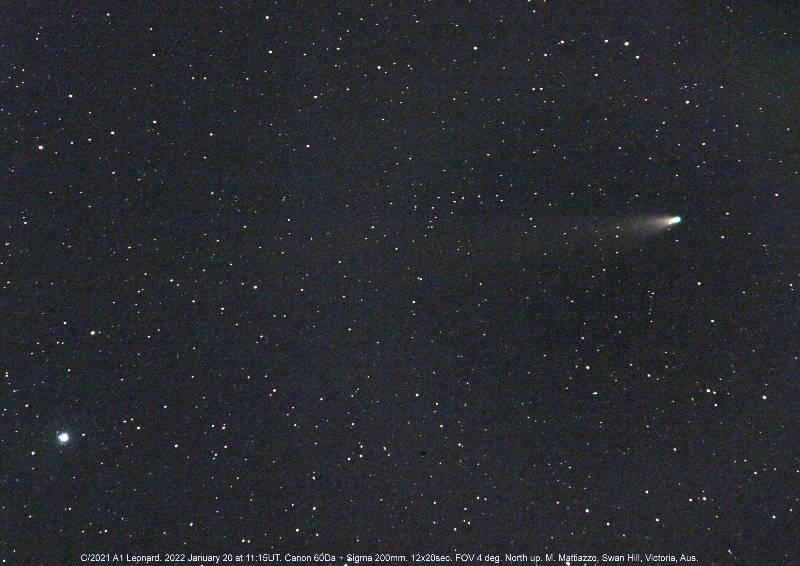
C/2021 A1 Leonard in outburst again!
2022 January 20 at 11:15UT. Canon 60Da + Sigma 200mm. 12x20sec. FOV 4 deg. North
up. from, Swan Hill, Victoria, Aus.
Appears strongly condensed m1=7.2 using 15x70mm binoculars.
Last observation on Jan 15th m1=7.5.
Below: Comparison photo taken on 2022 January 15 at 11:15UT.
Although the tail appears less prominent, the head appears brighter in the Jan
20th image.

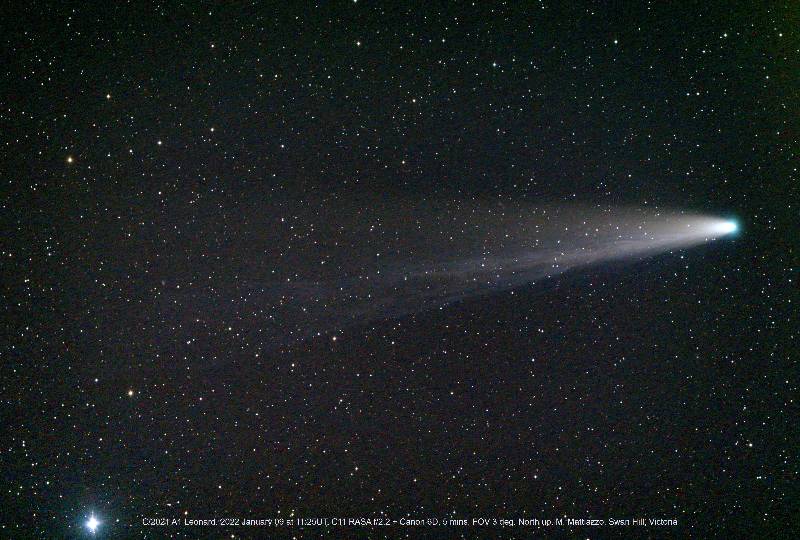
C/2021 A1 Leonard on 2022 January 09 at 11:25UT. 1 day post outburst. (January
8)
C11 RASA f/2.2 + Canon 6D. 5 mins. FOV 3 deg. North up. Swan Hill, Victoria,
Australia
Note that the ion tail, which has been absent over the past couple of days has
now grown into prominence after the January 8 outburst.
Visual estimate through 8x40mm m1=5.8, dia5' DC7. The m2 has faded by 0.5
magnitudes from previous night

Significant outburst of comet C/2021 A1 Leonard on January 8.48UT.
Visual m1 estimate = 5.4 through 8x40mm binoculars, about 1.3 magnitudes
brighter than 24 hrs prior.
(Observation on January 7.48UT through 8x40mm m1= 6.7)
Through 20cm reflector, bright starlike mag 7 nucleus appears inside a strongly
condensed coma.
In this telephoto shot, note the bright green head due to diatomic Carbon (which
is short lived)

C/2021 A1 Leonard. 2022 January 06 at 11:30UT. C11 RASA f/2.2 + Canon 6D. 5
mins. FOV 3 deg.
magnitude estimate around 6.2
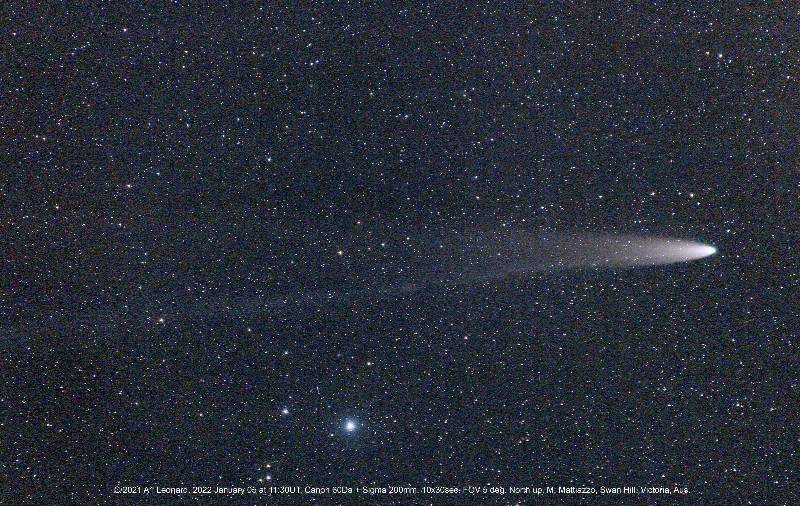
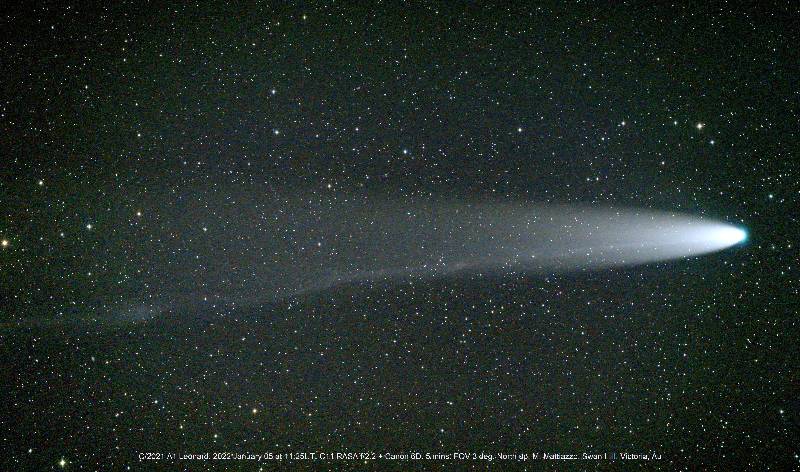
C/2021 A1 Leonard on 2022 January 05 at 11:25UT. C11 RASA f/2.2 + Canon 6D. 5
mins. FOV 3 deg. North up.
Swan Hill, Victoria, Australia. Comet now beyond naked eye visibility.
Estimate through 8x40mm binoculars m1= 5.8, coma 5' DC6. Comet continues to
fade.
Nuclear m2 estimate through 25x100mm binoculars was magnitude 9.0, further
fading from previous night

C/2021 A1 Leonard on perihelion day 2022 January 03 at 11:25UT. C11 RASA f/2.2 +
Canon 6D. 5 mins. FOV 3 deg. North up.
from Swan Hill, Victoria, Australia. Naked eye estimate 5.1, fading slowly.
Nuclear m2 estimate through 25x100mm binoculars was magnitude 8.5, Significant
fading from previous night

C/2021 A1 Leonard on 2022 January 02 at 11:25UT.
C11 RASA f/2.2 + Canon 6D. 5 mins. FOV 3 deg. North up. from Swan Hill,
Victoria, Australia.
There is Incredible detail showing up in the ion tail. Naked eye estimate 4.8.
Tail through 8x40mm binoculars is longer than 5 degrees.
m2 estimate through 25x100mm binoculars was magnitude 7.5, possible mini
outburst. Bright centre strongly condensed coma
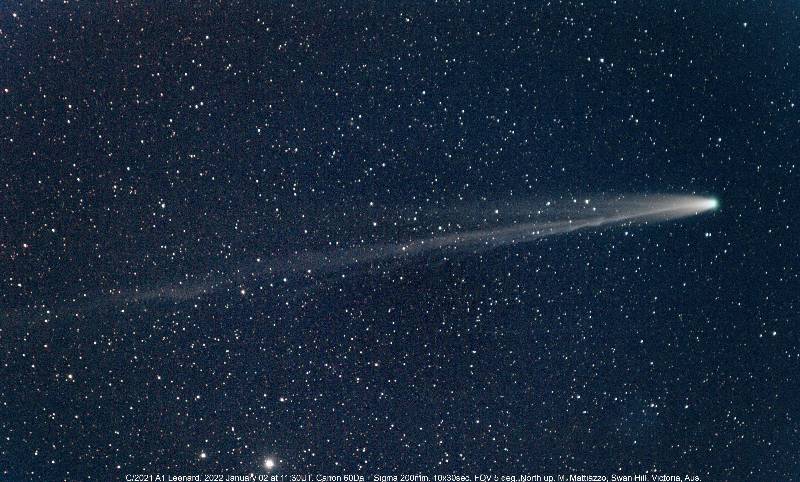
Telephoto view of comet C/2021 A1 Leonard on 2022 January 02 at 11:30UT.
Canon 60Da + Sigma 200mm. 10x30sec. FOV 5 deg. North up

Comet C/2021 A1 Leonard on 2021 December 31 at 11:25UT. 1 day post outburst
C11 RASA f/2.2 + Canon 6D. 4 mins. FOV 3 deg. North up.
Naked eye estimate 4.9. Comet displays a great deal of ion tail activity.

And the surprises continue with comet C/2021 A1 Leonard. In outburst once again,
albeit minor. (0.5 mag)
2021 December 30 at 11:25UT. C11 RASA f/2.2 + Canon 6D. 5 mins. FOV 3 deg. North
up.
Comet naked eye visual mag 4.5.
Through a 20cm reflector, the very bright nucleus was surrounded by a strongly
condensed circular coma 9' across and 2 degree dust tail in PA90.

Comet C/2021 A1 Leonard as seen in last nights ASV live stream. 2021 December 29
at 11:25UT. C11 RASA f/2.2 + Canon 6D.
5 mins. FOV 3 deg. North up. Ion tail not as active tonight, when compared to 24
hours earlier.
No visual estimate made, but reported at magnitude 5.0
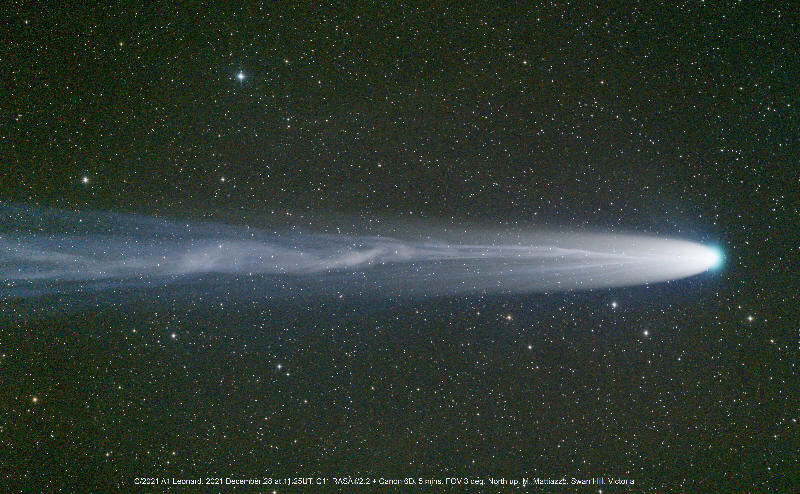
C/2021 A1 Leonard on 2021 December 28 at 11:25UT.
using a C11 RASA f/2.2 + Canon 6D. 5 mins. FOV 3 deg. North up. near Swan Hill,
Victoria. Dark skies really helped with comet viewing.
Naked eye visual estimate = 4.7. Very active ion tail development (from possible
outburst on 27th)
Through 15x70mm binoculars, the first 4 degrees of tail were bright, with a faint
extension to about 9 degrees.
Photographically, the tail appeared at least 18 degrees long, stretching towards Fomalhaut.

part of the comets tail.



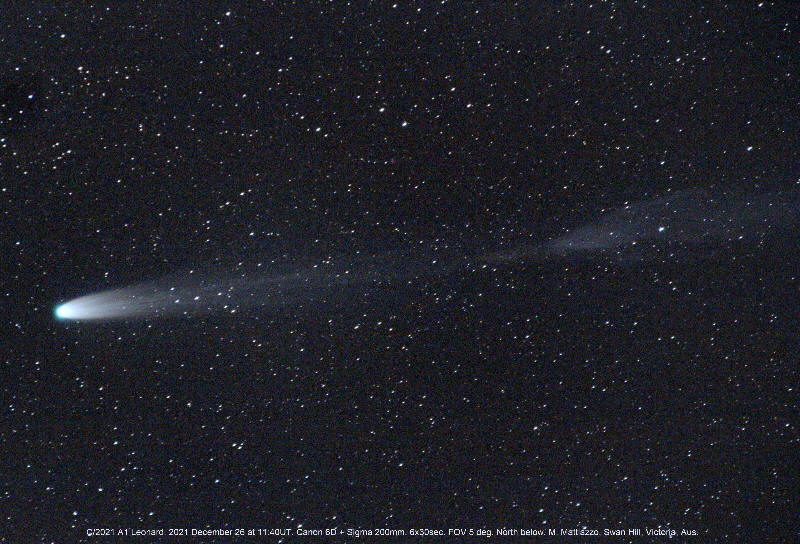
C/2021 A1 Leonard on 2021 December 26 at 11:40UT.
Canon 6D + Sigma 200mm. 6x30sec. FOV 5 deg. North below. The comet appeared
magnitude 4.3 naked eye.
Through 15x70mm binoculars, the ion tail can be traced to over 10 degrees in
length, with a bright feature located 4.3 degrees from the head.
This feature is a disconnection of the ion tail.
In the second image, At 70mm focal length, the ion tail is traceable to >15
degrees.
.
Comet C/2021 A1 Leonard on 2021 December 22 at 11:40UT.
using a Canon 6D + Sigma 200mm lens. 10x30sec. FOV 10 deg. North below. Image
taken near Tailem Bend, South Aus.
Naked eye estimate 4.0.
Through 25x100mm binoculars, the comet was a superb sight, with a star like
nucleus embedded in a parabolic hood.
The first 1.5 degrees of tail (dust) was quite bright.
In this image, the ion tail is greater than 10 degrees long. Note the
disconnection about halfway up.

Comet C/2021 A1 Leonard on 2021 December 21 at 11:15UT. C11 RASA f/2.2 + Canon
6D.
3 mins. FOV 3 deg. North up. Swan Hill, Victoria, Australia.
1 day post outburst. Although the comet has faded a bit (estimated 3.5 mag) the
development is massive.
Ion tail streamers as well as a parabolic dust hood and short dust tail have
formed.

Another outburst of comet C/2021 A1 Leonard!
It was easily visible naked eye at an altitude of 12 degrees on 2021 December
20.47UT.
estimating magnitude=2.9, corrected for extinction using the summer table.
Strongly condensed DC 8.
My observation in binoculars 2 days ago on 2021 Dec 18.47UT, was m1=4.2, using
8x40mm binoculars, coma 5’ DC7.

The comet had an
exceptionally close encounter with Venus on 2021 Dec 18 at 4 million kms.
Visual estimate using 8x40mm binoculars was 4.2, corrected for atmospheric
extinction.

During the first 2 weeks of December 2021, the comet had shown a significant
slowdown in activity, leading to the suggestion that the comet was at risk of
disintegrating. (and still is)
The comet was lagging behind at 5th magnitude as of December 11th.
However, on December 14th, reports of an outburst to 2nd magnitude had occurred,
with photos revealing a parabolic dust hood.
I recovered the comet from the southern hemisphere on the evening of December
16th, when only 3 degrees above the horizon (deep in twilight) at approximate
magnitude 4.0

C/2021 A1 Leonard rendezvous with globular cluster Messier 3. 2021 December 03
at 12:15UT.
T68 New Mexico. C11 RASA +CCD. 10 min. FOV 2 deg. North left.
Earth crosses the orbital plane of the comet on December 7, hence the sharply
defined dust tail in this image.

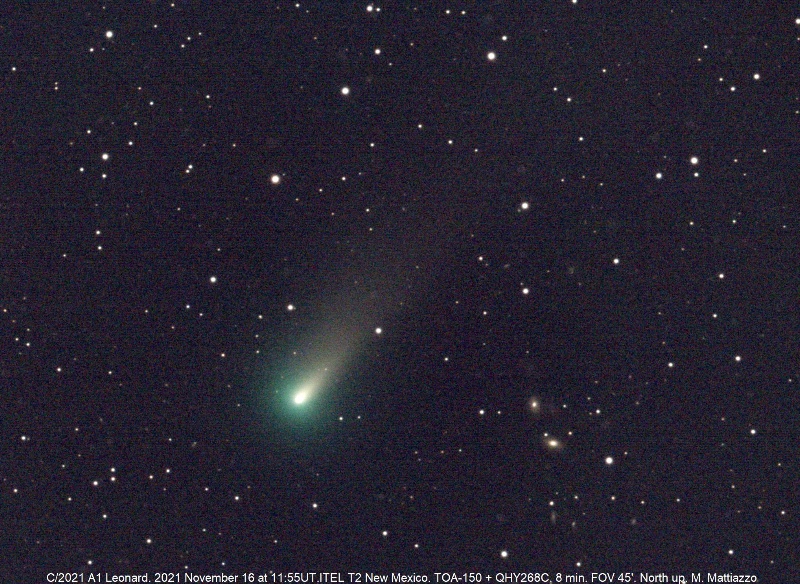

VIEWING EARLY DECEMBER NORTHERN HEMISPHERE
UK chart for between December 1st to 11th in the pre-dawn morning sky.
Comet traverses Bootes and Serpens, brightening rapidly from magnitude 6.5 to
4.0
Note encounter with globular cluster Messier 3 on December 3rd.
Orbit Plane crossing occurs on December 8th. Northern Hemisphere observers will
then view the dust tail edge-on
Tail should appear as a narrow spike with possibly an anti-tail in the solar
direction.

VIEWING MID-DECEMBER NORTHERN HEMISPHERE
UK chart for December 10th to 25th in the twilight evening sky, located
very low to the horizon.
Comet traverses Ophiuchus and Sagittarius
Comet is closest to Earth on 2021 Dec 12 at 0.23AU (35 million kms).
Maximum phase angle of 160 degrees occurs on December 14 with comet at its
brightest.
Note that the Ion tail will be perpendicular to horizon, so if comet is below
the horizon,
attempt to photograph the ion tail.
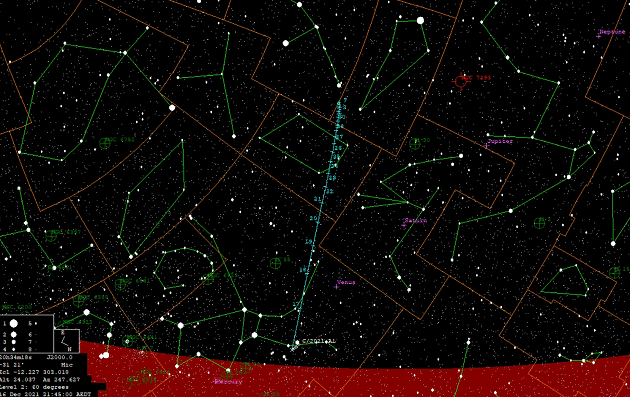
VIEWING from MID-DECEMBER SOUTHERN HEMISPHERE
chart for 35 South latitude in the Evening sky, very low to the horizon
initially. Visibility will rapidly improve with each night
Comet traverses Sagittarius and Microscopium, fading each night.
By end of December, comet is expected to fade to magnitude 4-6, assuming it
hasn't disintegrated by then.

printable chart
Perihelion occurs on 2022 January 3 at 0.61AU from Sun, but distance to Earth
has increased to 0.92AU.
Moonlight free period from Dec 21.


Image taken remotely from New Mexico on 2021 October 10.
The comet appears quite dusty, showing a dust fan 4’ long to the North,
Approximate magnitude 12.5

































